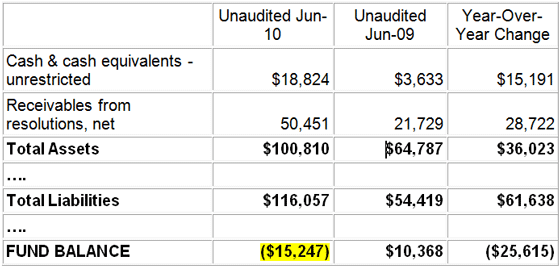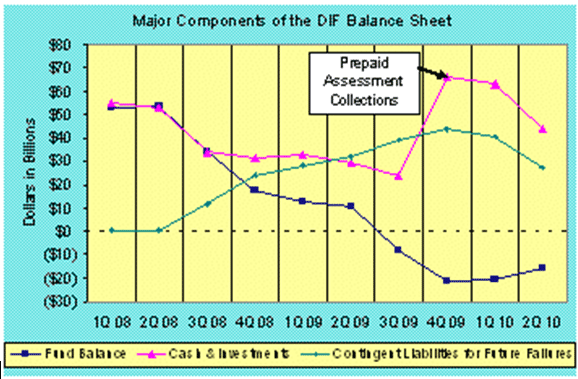FDIC Loses $25 Billion in One Year
by Alex Daley
With talk of quantitative easing round 2 (or QE2 for short), the potential government bailouts of Fannie Mae and Freddie Mac, and mounting problems with state finances, government pension funds, and funding for social programs all coming to a boil ahead of this election season, one thing seems to be abundantly clear: there is much more federal spending still to come. Hundreds of billions more.
As if that list of problems and that pile of (soon to be freshly printed) money weren’t enough, it seems we’re not done footing the bill for the colossal stupidity of the banking sector that was supposed to have been wiped clean in round one.
This time, again, it’s an agency whose charter is supposed to be to insulate citizens from the inevitable failure of a handful of banks each year, the Federal Deposit Insurance Corporation (FDIC). And according to their most recent financials for the organization’s primary operating vehicle, the Deposit Insurance Fund (DIF), they are not just due to go broke like many have predicted, they are broke already.
As of June 2010, the bottom line is that the FDIC is in the hole $15 billion. Their balance sheet tells the picture pretty clearly. The highlights (in millions):
Despite increased assets, the overwhelming majority of which are receivables from resolutions the organization has taken on (“resolutions” is the term the FDIC uses on financials to refer to the failed banks it takes over, basically), liabilities have increased at nearly double the rate, leaving the FDIC with a massive deficit.
This is not the first quarter the organization has ended in the red. It actually dipped into negative territory at the end of the third quarter last year. The balance has been negative every quarter since, dropping by over $25 billion since the same time last year.
To ensure that cash flows for the organization didn’t dry up in the wake of increasing liabilities, at the end of last year the fund passed a measure requiring member institutions to prepay their assessments for all of 2010, 2011, and 2012. It provided the organization a cash cushion to cover mounting losses – 139 banks have failed thus far in 2010, compared to 140 total in 2009, only 25 in 2008, and just three in 2007 – but also constrains their incoming cash for the next few years. Add together increased assessments of $3.6 billion this quarter and a few overestimated insurance losses no longer on the liabilities side of ledger, and the situation appears to be improving a bit from $20 billion to $15 billion in red ink.
But that improvement is mostly an illusion, as with limited assessments coming in for the next few years the FDIC is left playing a shell game of fulfilling liabilities from current failures with the assets and incoming cash from newer ones. This dangerous cash flow game is pinned on a few potentially precarious trends.
First, the FDIC’s hope is that liabilities from the failures do not increase beyond their current estimates, and is partially banking on those liabilities being lower than first thought. With loss-share deal valuations for failed institutions, where an acquiring bank helps cover a large portion of potential losses, improving along with the confidence of the firms acquiring them (the second trend the FDIC is betting on), this was the case for a short while. However, more recently they’ve had trouble getting their failed firms acquired at all. Just recently they were unable to find any buyers for First Arizona Savings, with its purported $272 million in assets, and the FDIC had to approve the payout of all insured deposits without any loss-share bank.
Lastly, they are betting that assets from the string of coming failures keep flowing into the fund for some time. Unlike the prior bets, this one seems like a sure-fire bet. The FDIC’s list of troubled institutions has only risen of late, jumping to 820 in Q2 from 775 in Q1. In Q2 the firm was named receiver on 45 failed institutions, and in just one day in mid-October, the regulators shut down 7 more.
All of these fresh assets allow them to continue operating in the red for a while longer. But the fundamental truth remains: the FDIC is broke.
Even with the one-time influx of prepaid dues and continuing flow of new assets keeping them afloat for now, there will continue to be less coming in than going out of DIF coffers. When bank failures finally do slow, the shell game will quickly come to an end and the liabilities will still be hanging over the fund’s head. The only choice at that point will be to increase assessments to member banks or seek funds elsewhere. Ask yourself, do you think the member banks responsible for maintaining the fund will pony up billions more from their own bottom lines to shore up the funds?
As a quasi-government entity, much like Fannie and Freddie but with even closer ties to federal regulators, the ultimate responsibility for the FDIC’s obligations will fall back to the government. And taxpayers will find themselves once again footing the bill for the bankers who tied themselves up in dubious securities and debts.
$15 billion might not seem like much relative to all the bailouts, stimuli, and other programs of late (when did that happen?). But you can probably safely consider the FDIC’s balance sheet as one more taxpayer IOU on top of the massive, mounting pile of debts our federal government will eventually have to account for – a pile that’s already $15 trillion or so.


Comments are closed.